



One of the largest near-Earth asteroids, 3122 Florence, passed by our planet on September 1, 2017 at about 18 times the distance to the Moon. A concerted observational campaign has led to many new insights, including the discovery of two moons orbiting Florence and new information on the physical properties of Florence itself.
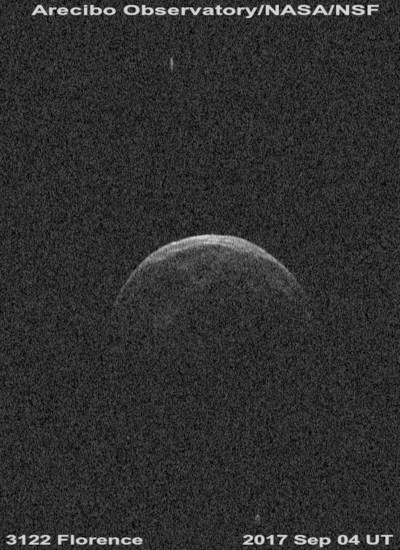
Radar images of asteroid Florence obtained with the 70-meter Goldstone antenna on Aug. 30 and 31 by Lance Benner, Marina Brozovic, Shantanu Naidu, and Jon Giorigini (JPL/Caltech) revealed that Florence is actually a system of three objects with two small moons revolving about a large, rounded, central body about 4.5 km (2.8 miles) across. Much higher resolution radar images were obtained at the National Science Foundation’s Arecibo Observatory between September 2 and 5 by Patrick Taylor, Anne Virkki, Flaviane Venditti, Luisa Zambrano-Marin, Carolina Rodriguez Sanchez-Vahamonde, and Betzaida Aponte-Hernandez and Edgard Rivera-Valentin. The Arecibo images suggest that the inner moon is roughly 180 to 240 m (600 to 800 feet) in size and that the outer moon is 300-360 m (1000 to 1200 feet) across. Each moon is somewhat elongated and appears oriented so the same hemisphere always faces Florence as it orbits, just as the same hemisphere of our own Moon always faces Earth.
Preliminary estimates of the orbital periods of the Florence moons using images obtained at Goldstone and Arecibo give values of about 21 to 23 hours for the outer moon and 7 to 8 hours for the inner moon. The inner moon of Florence has the shortest orbital period of any of the moons of the 60 near-Earth asteroids known to have moons. Accurate estimates of the orbital periods are important because they can be used to estimate the total mass and density of the asteroid. For example, the approximate period of 7 hours for the inner moon indicates that the bulk density of Florence is about 1.4 g/cm^3. That is much less dense than most solid rocks on Earth and it implies that the interior of this asteroid has substantial porosity. The entire suite of radar observations should provide more precise estimates of the orbital periods of the two moons and a more detailed analysis of the data is underway.
Joseph Pollock (Appalachian State Univ.), Petr Pravec (Ondrejov Observatory, Czech Republic), Michael Hicks (Jet Propulsion Laboratory, California Institute of Technology), and Brian Warner (Center for Solar System Studies) used optical measurements of brightness variations (known as “lightcurves”) during the close approach to estimate the rotation period of Florence. The observations were obtained with a suite of telescopes in Chile, North Carolina, and California. They obtained a period of 2.4 hours that is consistent with previously published values and with the independent estimate obtained by tracking the rotation of prominent features in the radar images. Combined with detailed radar imaging, the lightcurve observations will be used to accurately estimate the asteroid’s rotational pole direction and produce a detailed three-dimensional shape for the central body.
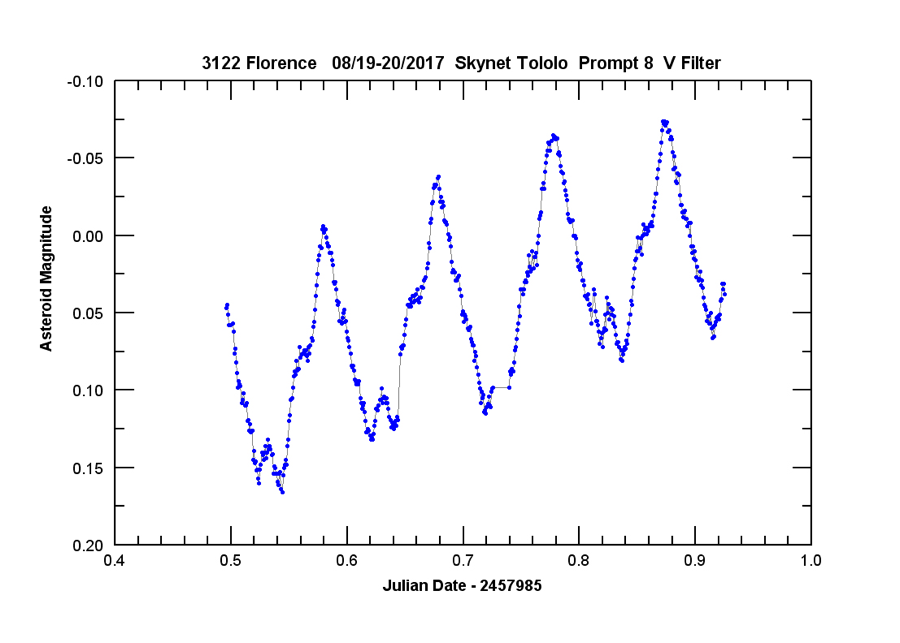
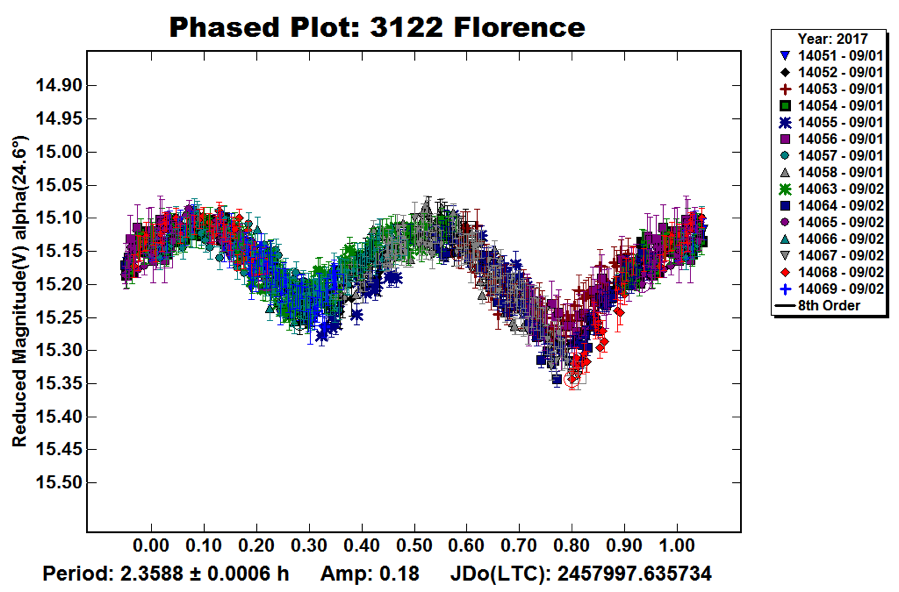
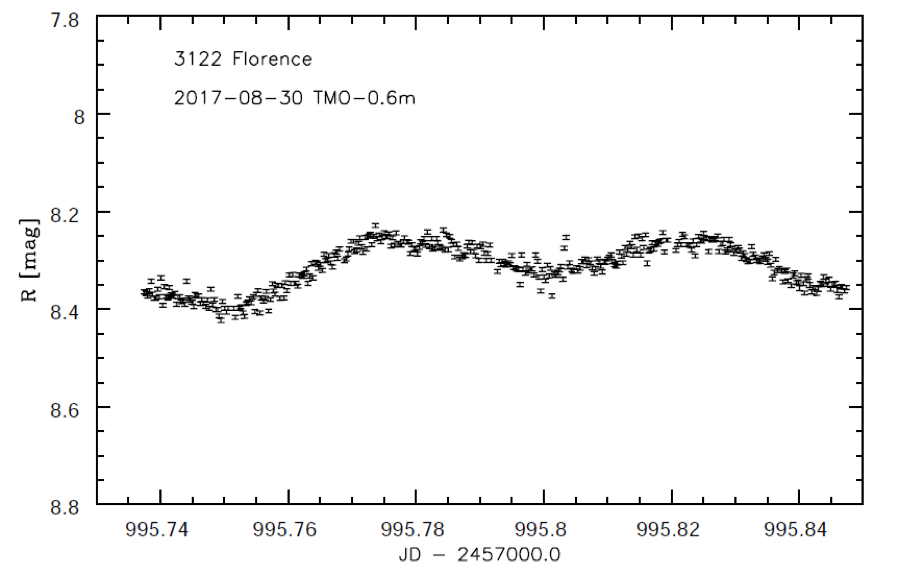

Vishnu Reddy (University of Arizona) and Juan Sanchez (Planetary Science Institute) used NASA’s Infrared Telescope Facility in Hawaii to obtain visible-near infrared spectroscopy to investigate the composition of Florence. Their measurements revealed that the composition of Florence is very similar to that of the “ordinary chondrite” or “stony” meteorites, which are the most common meteorites found falling on Earth. The asteroid that exploded over Chelyabinsk, Russia in February 2013 had a similar composition.
The main body of the Florence system has a generally rounded appearance, not the elongated shape that some other near-Earth asteroids have. The radar images indicate that the central body is somewhat “squished” at its poles and wider at its equator, producing an overall shape that resembles a top. Several other near-Earth asteroids have been observed with this general shape, including 101955 Bennu, the target of the asteroid sample return mission OSIRIS-REx. A top-like shape is thought to provide strong evidence that the interior of the central body consists of a “rubble pile” of many small blocks rather than a single, cohesive body.
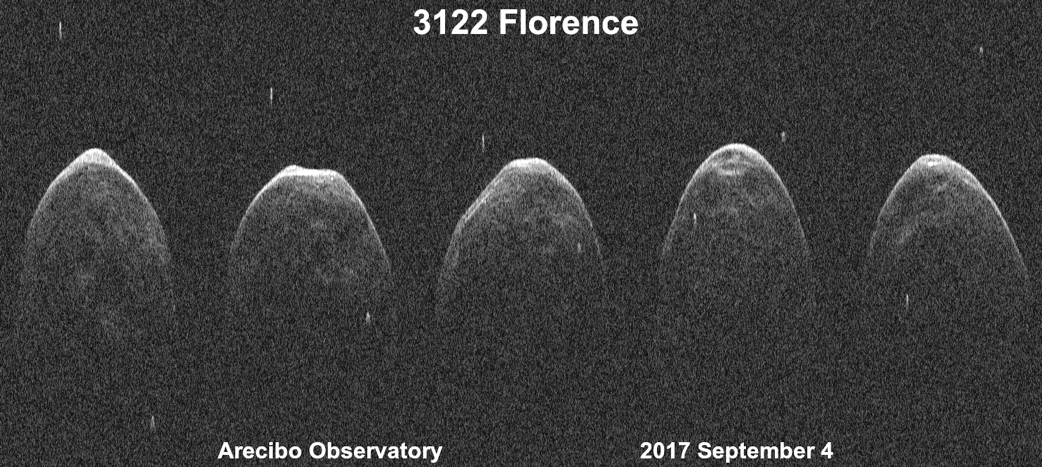
The high-resolution Arecibo radar images show a complex ridge at or near its equator of Florence and reveal more detail than was seen in the Goldstone images. Equatorial ridges have been seen on several other rapidly-rotating near-Earth asteroids that have moons and on some that apparently do not. Florence’s rapid 2.4-hour rotation period and diameter indicate that regions near the asteroid’s equator are rotating almost fast enough for material to lift off the surface due to the spin.
Features in the equatorial region vary with longitude and include local topographic lows and highs and two adjacent regions that are relatively flat. The Arecibo images show a cluster of four depressions that may be craters. The largest of these features is several hundred meters across and the others appear to be about 1/3 to 1/2 as large. Several smaller crater candidates are visible in the Arecibo images as are numerous small, bright features that may be small hills or large boulders. Researchers will work to determine the precise direction of the rotational pole from the radar images. This important physical property is known for only about 50 near-Earth asteroids to date. The pole direction is an important parameter for understanding the orbital evolution of asteroid Florence from its presumed origin within the main asteroid belt between Mars and Jupiter into its current orbit that crosses into the near-Earth region.
How did the two moons of Florence form? The general explanation for asteroid-moon formation is that loose material spins away from the equator of an asteroid as its rotation rate accelerates due to absorption of sunlight and reemission of heat in a preferential direction. The emission of heat provides a very small force that, over time, can make an asymmetrically shaped asteroid spin more rapidly (or more slowly depending on the pole direction). For an object that consists of a granular material, the accelerating rotation can eventually cause material at the equator to separate and go into orbit about the central body. Because many details of this process are poorly understood, observations of systems like Florence can improve our understanding of how some asteroids form moons.